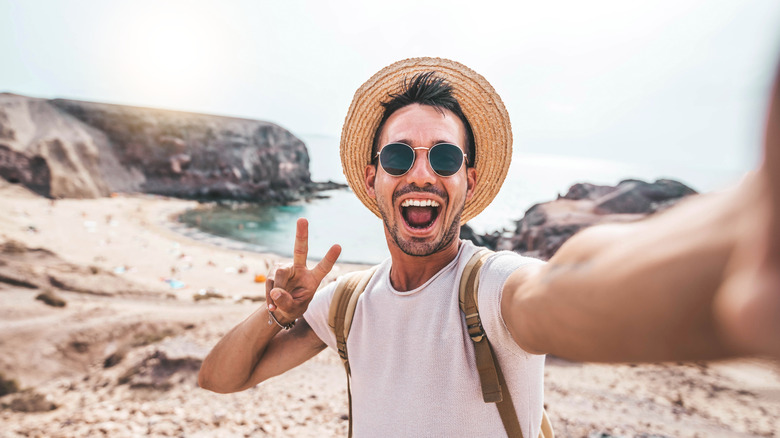Why Science Says Taking A Selfie Is More Likely To Result In Death Than A Shark Attack
When you think of deadly pastimes, what springs to mind? Skydiving? Bungee jumping? How about taking selfies? Selfies might seem innocuous, but they can actually be pretty dangerous. The first selfie dates back to 1839, according to CNN, but self-portrait photographs really took off in the early 2000s, according to Rangefinder. The first dictionaries added selfie as an official word in 2013. Now, selfies are a staple of social media, and at tourist attractions, it's not uncommon to see large groups of travelers with their backs to famous monuments, holding their phones up in front of them for a snap.
Still, this common practice can be shockingly deadly. Researchers identified at least 259 selfie-related deaths worldwide during a six-year period beginning in 2011, according to the Journal of Family Medicine and Primary Care (posted at the National Library of Medicine). That's more than 40 deaths a year on average, making selfies more deadly than skydiving, which caused the deaths of around 15 people in 2019, according to the United States Parachute Association; bungee jumping, which kills around one person each year, according to Health Research Funding; and, yes, shark attacks, which led to 11 fatalities in 2021, according to Florida Museum.
Why are selfies so dangerous?
When you think about sharks, it's not hard to see where the danger comes in. Big predator + big teeth = dangerous. But the situation is a little more complex for selfies. What exactly is causing so many people to die while taking photos of themselves? It turns out it comes down to risk-taking (via the New York Post). A poll conducted by cellphone case maker Case24.com, via News 4 Jax, found that people were willing to venture into pretty dangerous territory to get a good shot. As many as 41% of people said in the poll they had risked their safety for a selfie.
Some of the most common causes of death during selfies include drowning and falling (via the National Library of Medicine). Other causes of death can include car crashes or interactions with dangerous animals while posing for selfies. Sure, you might love a snapshot with that gorgeous tiger — but don't forget that you're getting up close and personal with an apex predator.
This risk-taking, combined with the widespread popularity of selfie-taking, means more people die each year taking photos of themselves than from shark attacks, skydiving, or bungee jumping — or from all of these things combined, for that matter.
Why we're more afraid of sharks than selfies
If sharks are less deadly than selfies, you might wonder why we're still afraid of them. The act of picking up a phone to snap a picture doesn't exactly inspire fear, after all, even with the knowledge of how many people die while taking selfies each year.
In fact, this discrepancy is a good example of the irrationality of human fears. As National Geographic notes, human brains can't necessarily process things like statistics and safety measures. But when you see a shark — with its big, gleaming teeth and black eyes — you don't have to think rationally to be afraid.
Over time, evolution may have primed our brains to develop certain fears more easily than others. For instance, studies have suggested that even young kids are terrified of snakes, according to CBC. That makes sense when you consider people who were more likely to be scared of snakes were also more likely to steer clear from them — and so they would be the ones to survive and pass down their genes to future generations.
Other unexpectedly deadly things
Selfies aren't the only unexpected killer in our midst. There are plenty of other mundane things you might not fear that actually lead to deaths For instance, in the U.S. alone, almost 1,000 people were killed by lawnmowers from 1999 to 2014, and another 1,413 die after falling out of trees during that same 15-year time span (via Insider).
Still, keep in mind that in the grand scheme of things, millions of people die each year — as many as 60 million people annually, according to The World Counts. That means even selfies, which killed over 250 people during a six-year period, are a rare cause of death. The most common causes of death worldwide include heart disease, stroke, and lung illnesses like chronic obstructive pulmonary disease, or COPD (via the World Health Organization). That means if you're trying to reduce your risk of dying prematurely, you should probably focus on evidence-based lifestyle changes that lower your risk of disease. Stopping your selfie habit is unlikely to do much.



